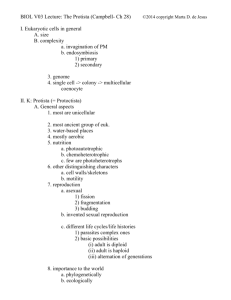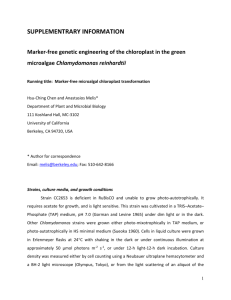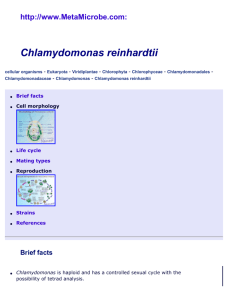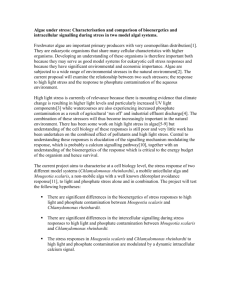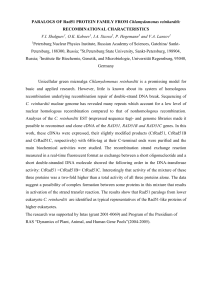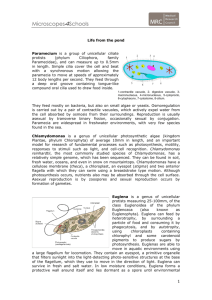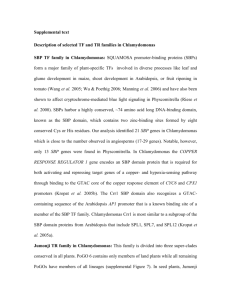TEA_2010_Poster Chlamy
advertisement
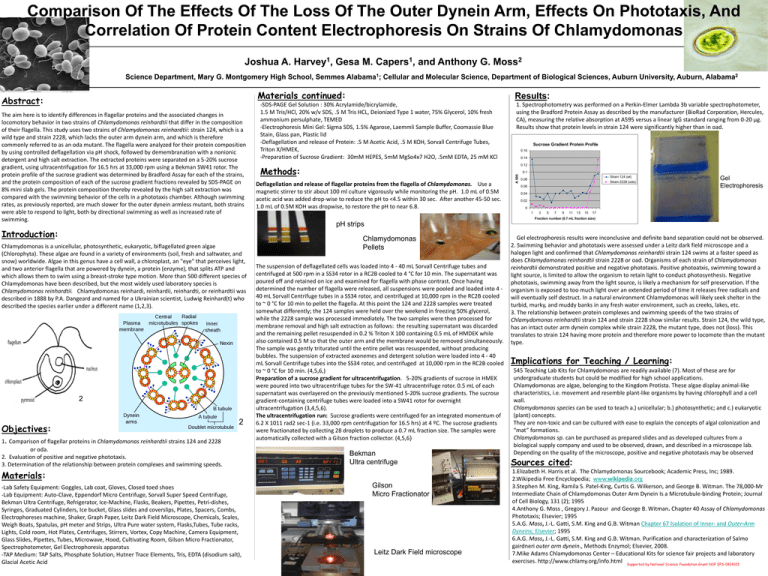
Comparison Of The Effects Of The Loss Of The Outer Dynein Arm, Effects On Phototaxis, And Correlation Of Protein Content Electrophoresis On Strains Of Chlamydomonas Joshua A. 1 Harvey , Gesa M. 1 Capers , and Anthony G. 2 Moss Science Department, Mary G. Montgomery High School, Semmes Alabama1; Cellular and Molecular Science, Department of Biological Sciences, Auburn University, Auburn, Alabama2 Materials continued: The aim here is to identify differences in flagellar proteins and the associated changes in locomotory behavior in two strains of Chlamydomonas reinhardtii that differ in the composition of their flagella. This study uses two strains of Chlamydomonas reinhardtii: strain 124, which is a wild type and strain 2228, which lacks the outer arm dynein arm, and which is therefore commonly referred to as an oda mutant. The flagella were analyzed for their protein composition by using controlled deflagellation via pH shock, followed by demembranation with a nonionic detergent and high salt extraction. The extracted proteins were separated on a 5-20% sucrose gradient, using ultracentrifugation for 16.5 hrs at 33,000 rpm using a Bekman SW41 rotor. The protein profile of the sucrose gradient was determined by Bradford Assay for each of the strains, and the protein composition of each of the sucrose gradient fractions revealed by SDS-PAGE on 8% mini slab gels. The protein composition thereby revealed by the high salt extraction was compared with the swimming behavior of the cells in a phototaxis chamber. Although swimming rates, as previously reported, are much slower for the outer dynein armless mutant, both strains were able to respond to light, both by directional swimming as well as increased rate of swimming. Introduction: Chlamydomonas is a unicellular, photosynthetic, eukaryotic, biflagellated green algae (Chlorophyta). These algae are found in a variety of environments (soil, fresh and saltwater, and snow) worldwide. Algae in this genus have a cell wall, a chloroplast, an "eye" that perceives light, and two anterior flagella that are powered by dynein, a protein (enzyme), that splits ATP and which allows them to swim using a breast-stroke type motion. More than 500 different species of Chlamydomonas have been described, but the most widely used laboratory species is Chlamydomonas reinhardtii. Chlamydomonas reinhardi, reinhardii, reinhardti, or reinhardtii was described in 1888 by P.A. Dangeard and named for a Ukrainian scientist, Ludwig Reinhard(t) who described the species earlier under a different name (1,2,3). 2 Objectives: 1. Comparison of flagellar proteins in Chlamydomonas reinhardtii strains 124 and 2228 2 or oda. 2. Evaluation of positive and negative phototaxis. 3. Determination of the relationship between protein complexes and swimming speeds. -SDS-PAGE Gel Solution : 30% Acrylamide/bicrylamide, 1.5 M Tris/HCl, 20% w/v SDS, .5 M Tris HCL, Deionized Type 1 water, 75% Glycerol, 10% fresh ammonium persulphate, TEMED -Electrophoresis Mini Gel: Sigma SDS, 1.5% Agarose, Laemmli Sample Buffer, Coomassie Blue Stain, Glass pan, Plastic lid -Deflagellation and release of Protein: .5 M Acetic Acid, .5 M KOH, Sorvall Centrifuge Tubes, Triton X/HMEK, -Preparation of Sucrose Gradient: 30mM HEPES, 5mM MgSo4x7 H2O, .5mM EDTA, 25 mM KCl Sucrose Gradient Protein Profile 0.16 0.14 0.12 Methods: 0.1 Deflagellation and release of flagellar proteins from the flagella of Chlamydomonas. Use a magnetic stirrer to stir about 100 ml culture vigorously while monitoring the pH. 1.0 mL of 0.5M acetic acid was added drop-wise to reduce the pH to <4.5 within 30 sec. After another 45-50 sec. 1.0 mL of 0.5M KOH was dropwise, to restore the pH to near 6.8. Strain 124 (wt) Strain 2228 (oda) 0.08 0.06 Gel Electrophoresis 0.04 0.02 0 1 3 5 7 9 11 13 15 17 Fraction number (0.7 mL fraction size) pH strips Chlamydomonas Pellets The suspension of deflagellated cells was loaded into 4 - 40 mL Sorvall Centrifuge tubes and centrifuged at 500 rpm in a SS34 rotor in a RC2B cooled to 4 °C for 10 min. The supernatant was poured off and retained on ice and examined for flagella with phase contrast. Once having determined the number of flagella were released, all suspensions were pooled and loaded into 4 40 mL Sorvall Centrifuge tubes in a SS34 rotor, and centrifuged at 10,000 rpm in the RC2B cooled to ~ 0 °C for 10 min to pellet the flagella. At this point the 124 and 2228 samples were treated somewhat differently; the 124 samples were held over the weekend in freezing 50% glycerol, while the 2228 sample was processed immediately. The two samples were then processed for membrane removal and high salt extraction as follows: the resulting supernatant was discarded and the remaining pellet resuspended in 0.2 % Triton X 100 containing 0.5 mL of HMDEK while also contained 0.5 M so that the outer arm and the membrane would be removed simultaneously. The sample was gently triturated until the entire pellet was resuspended, without producing bubbles. The suspension of extracted axonemes and detergent solution were loaded into 4 - 40 mL Sorvall Centrifuge tubes into the SS34 rotor, and centrifuged at 10,000 rpm in the RC2B cooled to ~ 0 °C for 10 min. (4,5,6,) Preparation of a sucrose gradient for ultracentrifugation. 5-20% gradients of sucrose in HMEK were poured into two ultracentrifuge tubes for the SW-41 ultracentrifuge rotor. 0.5 mL of each supernatant was overlayered on the previously mentioned 5-20% sucrose gradients. The sucrose gradient-containing centrifuge tubes were loaded into a SW41 rotor for overnight ultracentrifugation (3,4,5,6). The ultracentrifugation run: Sucrose gradients were centrifuged for an integrated momentum of 6.2 X 1011 rad2 sec-1 (i.e. 33,000 rpm centrifugation for 16.5 hrs) at 4 ºC. The sucrose gradients were fractionated by collecting 28 droplets to produce a 0.7 mL fraction size. The samples were automatically collected with a Gilson fraction collector. (4,5,6) Bekman Ultra centrifuge Materials: -Lab Safety Equipment: Goggles, Lab coat, Gloves, Closed toed shoes -Lab Equipment: Auto-Clave, Eppendorf Micro Centrifuge, Sorvall Super Speed Centrifuge, Bekman Ultra Centrifuge, Refrigerator, Ice-Machine, Flasks, Beakers, Pipettes, Petri-dishes, Syringes, Graduated Cylinders, Ice bucket, Glass slides and coverslips, Plates, Spacers, Combs, Electrophoreses machine, Shaker, Graph Paper, Leitz Dark Field Microscope, Chemicals, Scales, Weigh Boats, Spatulas, pH meter and Strips, Ultra Pure water system, Flasks,Tubes, Tube racks, Lights, Cold room, Hot Plates, Centrifuges, Stirrers, Vortex, Copy Machine, Camera Equipment, Glass Slides, Pipettes, Tubes, Microwave, Hood, Cultivating Room, Gilson Micro Fractionator, Spectrophotometer, Gel Electrophoresis apparatus -TAP Medium: TAP Salts, Phosphate Solution, Hutner Trace Elements, Tris, EDTA (disodium salt), Glacial Acetic Acid 1. Spectrophotometry was performed on a Perkin-Elmer Lambda 3b variable spectrophotometer, using the Bradford Protein Assay as described by the manufacturer (BioRad Corporation, Hercules, CA), measuring the relative absorption at A595 versus a linear IgG standard ranging from 0-20 μg. Results show that protein levels in strain 124 were significantly higher than in oad. A 595 Abstract: Results: Gilson Micro Fractionator Leitz Dark Field microscope Gel electrophoresis results were inconclusive and definite band separation could not be observed. 2. Swimming behavior and phototaxis were assessed under a Leitz dark field microscope and a halogen light and confirmed that Chlamydomonas reinhardtii strain 124 swims at a faster speed as does Chlamydomonas reinhardtii strain 2228 or oad. Organisms of each strain of Chlamydomonas reinhardtii demonstrated positive and negative phototaxis. Positive photoatxis, swimming toward a light source, is limited to allow the organism to retain light to conduct photosynthesis. Negative phototaxis, swimming away from the light source, is likely a mechanism for self preservation. If the organism is exposed to too much light over an extended period of time it releases free radicals and will eventually self destruct. In a natural environment Chlamydomonas will likely seek shelter in the turbid, murky, and muddy banks in any fresh water environment, such as creeks, lakes, etc. 3. The relationship between protein complexes and swimming speeds of the two strains of Chlamydomonas reinhardtii strain 124 and strain 2228 show similar results. Strain 124, the wild type, has an intact outer arm dynein complex while strain 2228, the mutant type, does not (loss). This translates to strain 124 having more protein and therefore more power to locomote than the mutant type. Implications for Teaching / Learning: 545 Teaching Lab Kits for Chlamydomonas are readily available (7). Most of these are for undergraduate students but could be modified for high school applications. Chlamydomonas are algae, belonging to the Kingdom Protista. These algae display animal-like characteristics, i.e. movement and resemble plant-like organisms by having chlorophyll and a cell wall. Chlamydomonas species can be used to teach a.) unicellular; b.) photosynthetic; and c.) eukaryotic (plant) concepts. They are non-toxic and can be cultured with ease to explain the concepts of algal colonization and “mat” formations. Chlamydomonas sp. can be purchased as prepared slides and as developed cultures from a biological supply company and used to be observed, drawn, and described in a microscope lab. Depending on the quality of the microscope, positive and negative phototaxis may be observed Sources cited: 1.Elizabeth H. Harris et al. The Chlamydomonas Sourcebook; Academic Press, Inc; 1989. 2.Wikipedia Free Encyclopedia; www.wikipedia.org 3.Stephen M. King, Ramila S. Patel-King, Curtis G. Wilkerson, and George B. Witman. The 78,000-Mr Intermediate Chain of Chlamydomonas Outer Arm Dynein Is a Microtubule-binding Protein; Journal of Cell Biology, 131 (2); 1995 4.Anthony G. Moss , Gregory J. Pazour and George B. Witman. Chapter 40 Assay of Chlamydomonas Phototaxis; Elsevier; 1995 5.A.G. Moss, J.-L. Gatti, S.M. King and G.B. Witman Chapter 67 Isolation of Inner- and Outer-Arm Dyneins; Elsevier; 1995 6.A.G. Moss, J.-L. Gatti, S.M. King and G.B. Witman. Purification and characterization of Salmo gairdneri outer arm dynein., Methods Enzymol; Elsevier, 2008. 7.Mike Adams Chlamydomonas Center – Educational Kits for science fair projects and laboratory exercises. http://www.chlamy.org/info.html Supported by National Science Foundation Grant NSF EPS-0814103

